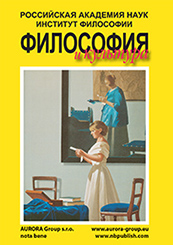History of ideas and teachings
Reference:
Skorokhodova, T.G. (2022). A Dream on Better Destiny for Motherland: Idea of Future India in Rabindranath Tagore’s poem ‘Where the Mind is Without Fear’. Philosophy and Culture, 7, 1–14. https://doi.org/10.7256/2454-0757.2022.7.38372
Abstract:
Among the key ideas of the Bengal Renaissance (XIX–early XX century) was one of a future India considered from the point of view of India's weal. An creative embodiment of the idea in Rabindranath Tagore’s poem ‘Where the Mind is Without Fear’ (1901) is analyzed in the article. Based on hermeneutical approach, the author traces an origin of the idea, its evolution in creative thought of the national-cultural renaissance in Modern India and its content in Tagore’s thought. The application of a principle of historicism helped to trace the emergence of ‘dreamland’ idea in Michael Madhusudan Dutta’s poetry, then its ‘antithesis’ in philosophy by Swami Vivekananda and next transformation into the image of future free India in Rabindranath Tagore’s poem. For the first time ‘Where the Mind is Without Fear’ has been philosophically considered in the broad context of the history of thought and culture in India from Rammohun Roy to Rabindranath Tagore. The poem is an application of social ideal of free society to future perspective of India; its practical embodiment is possible, but it depends from positive activity of Indian people. The poem represents a set of key ideas of the epoch such as renovation of spiritual life, overcoming of the dead rules, rational thinking of all life spheres, human liberation from traditional dependencies, finding of dignity and discovery of new ways of development. Moreover, Tagore maintains universal human problematic of freedom and circumstances of its embodiment in peoples’ life.
Keywords:
Swami Vivekananda, Michael Madhusudan Dutta, the idea of the future, culture, liberty, freedom, Rabindranath Tagore, social philosophy, the Bengal Renaissance, Modern India
Question at hand
Reference:
Barinov, N.N. (2022). Marxism-Leninism and Christianity: Continuation of I. Vostorgov's Research. Philosophy and Culture, 7, 15–43. https://doi.org/10.7256/2454-0757.2022.7.38417
Abstract:
This article is a study of the compatibility of the theory and practice of Marxism-Leninism and Orthodox Christianity. The great importance of this topic is due to its direct connection with the improvement of society and the ongoing controversy on this issue with attempts to integrate communism with Christianity. The work provides a historical and theological analysis based on a critical study of the works of the founders of Marxism-Leninism, their associates, historical and theological works, as well as historical documents on this issue. The article examines the approaches of the teachings of Orthodox Christianity, as well as Marxism-Leninism to atheism, materialism, religion and the Church. For this purpose, the relevant texts of Holy Scripture, the opinions of the Church fathers and the views of the founders and followers of Marxism-Leninism are studied. The novelty of this study is that some documents are considered for the first time in the context of the problem under study. In addition, a more detailed and systematic historical and theological analysis of the comparison of the teachings of Marxism-Leninism and Orthodox Christianity on this topic is carried out in comparison with the available works. The purpose of the work is to study historical and theological works, as well as historical documents related to the problem under study. The article concludes that Marxism-Leninism in this matter is not compatible with Christianity and is directly opposed to it. Since the Second World War in the USSR, relations between the state and the Church have improved from time to time, but the official state course on Marxism-Leninism did not leave the possibility of their reconciliation. Currently, there are attempts to produce a symbiosis of these two teachings. Many Communists have a positive attitude towards the Church, so a dialogue between them is possible and necessary. But as long as the ideology of the Communists remains Marxism-Leninism, antagonistic to Christianity and any religion in general, in their ranks will always remain hostile to religion. Therefore, the synthesis of these teachings is impossible.
Keywords:
apocatastasis, theodicy, partisanship in science, atheism, god - building, Church, materialism, Marxism-Leninism, Christianity, Orthodoxy
Ontology: being and nihility
Reference:
Kachay, I.S. (2022). Ontological determinant of the phenomenon of creativity in the conceptual space of non-classical philosophy. Philosophy and Culture, 7, 44–55. https://doi.org/10.7256/2454-0757.2022.7.38434
Abstract:
The subject of the study is the ontological nature of the phenomenon of creativity in the context of conceptual constructions of the most important nominal layers of non-classical philosophy. The aim of the work is to reveal the ontological essence of creativity in the context of European philosophy of the XIX–XX centuries based on the works of A. Schopenhauer, A. Bergson, J.-P. Sartre, A. Camus and M. Heidegger. The theoretical and methodological basis of the research is the works of representatives of the non-classical period of the development of philosophical thought, as well as the works of modern domestic and foreign researchers, in their works directly or indirectly touching on the problem of the ontological determinant of creativity. The central research methods are comparative and complex methods for establishing connections and relationships between phenomena that are part of the sphere of creative being, as well as an analytical and interpretive method for analyzing existing interpretations of the phenomenon under study and presenting the author's position. The scientific novelty of the research consists in the identification and systematization of philosophical ideas regarding the ontological determinant of creativity in the conceptual field of Western European non–classical philosophy of the XIX-XX centuries. As a result of the conducted research, the author comes to the conclusion that within the framework of non-classical philosophy, the ontological nature of creativity is revealed both at the level of objective reality (generation and change of existing being) and in the existential-personal space of the subject (self-creation and self-transcending through the implementation of irrational-volitional intentions and life-meaning orientations). Unlike the classical tradition of philosophizing, which absolutizes the epistemological component of the subject's creativity, in the subject field of non-classical philosophy, creativity regains its ontological rootedness, since it acts as the general existential of human existence, revealing itself through the prism of such concepts as the Will to live, pure duration, creative evolution, Vital impulse, imaginative consciousness, rebellion against the absurd, the promotion of truth and the way out of inauthenticity.
Keywords:
intuition, imagination, western European philosophy, non-classical philosophy, existing, genesis, creative act, the creative process, creativity, ontology
Question at hand
Reference:
Tsyangpin, G. (2022). M.A. Balakirev: the way to create a new school of composition. Philosophy and Culture, 7, 56–65. https://doi.org/10.7256/2454-0757.2022.7.38451
Abstract:
The subject of the article is the role of M.A. Balakirev in the development of Russian musical culture. The purpose of the article is to analyze the multifaceted activities of M.A. Balakirev, whom history itself has put forward to accomplish great things for the benefit of musical culture and musical education in Russia. In accordance with the theme and purpose, the following methods were used: retrospective analysis of the musical life of Russia in the second half of the XIX – early XX centuries; analysis of memoir sources of M.A. Balakirev's contemporaries; generalization of modern scientific research on the topic stated in the article. The methodology of the research consists of : memoirs of students and associates of M.A. Balakirev – Ts.A. Kui, N.A. Rimsky-Korsakov, V.V. Stasov; memoirs of Russian researchers – P.D. Bobrykin, Yu.V. Vasiliev, E.M. Gordeeva, Yu.V. Keldysh, I.F. Kunin. The novelty of the research lies in the identification of aesthetic contradictions between the established approach not only in the creative association of composers, but also in the musical art of that era. The materials of the article can be included in the course of lectures and seminars on the history of Russian music, advanced training courses for music teachers, teachers of secondary specialized and higher educational institutions. The conclusions of the study are : the purpose and creative activity of the composers of the "Mighty Bunch" under the leadership of M.A. Balakirev is characterized as a reflection of the Russian democratic culture of the era of revolutionary populism; the activity of the creative community "Mighty Bunch" is presented as embodying the ideological platform of the new Russian direction in music of the XIX century; the main methods of "composer" training and education applied by M.A. Balakirev.
Keywords:
Balakirev 's method, music training, Russian music pedagogy, pedagogical methods, composer 's school, musical culture, Russian culture, russian music, creative community, Mighty Bunch
Tradition and innovation
Reference:
Xie, J. (2022). Origin and development of primitive "porcelain" (proto-porcelain) in China. Philosophy and Culture, 7, 66–75. https://doi.org/10.7256/2454-0757.2022.7.38429
Abstract:
The article discusses the features of the development of Chinese primitive porcelain (proto-porcelain). The purpose of the article is to reveal the periodization of the development of Chinese porcelain in the early stages of its history and the influence of proto-porcelain on the so-called "mature" porcelain of later periods. Primitive porcelain, which is the transitional stage from earthenware to real porcelain, dates back to the era between the Shang Dynasty and the Eastern Han Dynasty. The study was conducted using historical and comparative methods, as well as the method of formal stylistic analysis. It was important to determine the characteristics of primitive porcelain and to reveal its role in the development of the global art of folklore production. The scientific novelty of the study lies in the fact that it not only reveals the time frame for the production of primitive porcelain in China and determines its technological and chemical properties, but also points out the influence factors of primitive porcelain on the historical development of Chinese and world porcelain. It was revealed that the origin of primitive porcelain dates back to the 16th-11th centuries BC, its development took place in the XI-II centuries BC, and the end of the era of primitive porcelain refers to the II-III centuries BC. Primitive porcelain has evolved over nearly two millennia. Having reached its peak, the technology of its manufacture provided the technological basis for the creation of "mature" porcelain. The conclusion is made about the significant influence that primitive porcelain had on Chinese, and through it – on world porcelain, largely determining the formation of this significant phenomenon of material culture.
Keywords:
Han dynasty, Shang Dynasty, China, chemical composition, firing, ceramics, protofarfor, porcelain, pottery, clay
The dialogue of cultures
Reference:
Ma, Z. (2022). Rethinking Chekhov's work in modern Chinese productions. Philosophy and Culture, 7, 76–86. https://doi.org/10.7256/2454-0757.2022.7.38398
Abstract:
This article is devoted to the consideration of a number of stage projects by Chinese directors, in which the work of the writer Anton Pavlovich Chekhov is reinterpreted. Analysis of such productions and projects as the international drama festival "Chekhov Forever" in 2004, a hybrid work based on Chekhov's story "Three Sisters" and Beckett's novel "Waiting for Godot" by Lin Zhaohua in 1998 and 2018, a double performance by Stan Lai based on the works "I take You by the Hand" by Carol Rocamora and "The Seagull" Chekhov 2014 , etc . It allows us to trace innovative approaches to reading Chekhov's works in the context of the life of modern Chinese society. These works cause a great resonance not only in the professional environment, but also among the mass audience, who invariably penetrates the depth of Chekhov's images, the subtlest shades of emotional experiences; the Chinese audience finds themselves close to the problems, hopes and aspirations of the heroes, brilliantly transferred to the actual socio-cultural environment of China, always topical and recognizable. The scientific novelty of the article is connected with the fact that the nature of mastering the creativity of the Russian playwright in the theater of the East is a fairly new and at the same time promising topic for research. The conclusions and results of the study can become the basis for further studies of the specifics of the adaptation of foreign dramaturgy in the national theatrical tradition on the example of other countries and regions.
Keywords:
Uncle Vanya, Seagull, Three sisters, theater project, interpretation, Chekhov, perception, Russian drama, China, drama theater
Philosophical anthropology
Reference:
Rozin, V.M. (2022). Experience of rational understanding of life and death (biological and social plans of evolutionary development). Philosophy and Culture, 7, 87–95. https://doi.org/10.7256/2454-0757.2022.7.38501
Abstract:
The article proposes to consider the phenomena of life and death within the framework of philosophical and scientific discourse. The author does not aim to explain the origin of life, he seeks to conceive of life and death on the basis of the methodology developed by him and the research conducted. The main way of understanding these phenomena is the hypothesis about the nature of the mechanism of life (the assumption of a "vital organization" responsible for activity and other life reactions is introduced), as well as cultural–historical and semiotic analysis of the evolution of life. In evolution, the author distinguishes three main stages: the formation of life, biological evolution and the evolution of social life. An important role in the latter is assigned, on the one hand, to the use of signs denoting not observable realities, but necessary for the management of the "primary team", on the other hand, technology. The technique performed two main functions: it expanded the capabilities of hominids in terms of creating the right environment (fire, tools, clothing, housing, etc.) and confirmed the use of signs, since it created a reality corresponding to their meanings. In social life, as well as in biological, two spheres need to be distinguished in the vital organization: one belongs to individuals (psyche, activity, corporeality, etc.), and the other, actually social (culture, sociality with its institutions, communication, collectives that include individuals), encompassing, without which the first cannot exist and function. Having asked the provisions indicated here, the author characterizes what death is and considers the cognitive dissonance that occurs when we try to rationally think about these phenomena.
Keywords:
organization, integrity, system, development, evolution, sociality, culture, individual, death, life
Philosophy and culture
Reference:
Abramychev, M.M., Gromov, B.Y. (2022). Identity crisis and social dissociation in control societies. Philosophy and Culture, 7, 96–108. https://doi.org/10.7256/2454-0757.2022.7.38362
Abstract:
The article is devoted to the problem of the naming crisis of modern society. The sequences by which the social and cultural history of the West is ordered, represented by the evolution of economics, technology, religion, forms of capital and wealth, communications, following the technological acceleration of time, coexist with each other, compete for primacy, creating a society of atomized subjects who have ceased to understand their place in the history of society. This situation is described in the article as an identity crisis. The purpose of this work is to demonstrate the gaps that have been discovered in attempts to identify society, which are the object of criticism. The article refers to the tradition of explanatory modeling of social interactions in terms of psychopathology and psychiatry. The crisis of the identity of society is illustrated through the images of madness in modern art culture. The article hypothesizes that there is an unspoken ban on naming a society associated with the crisis of capitalism in the transition from disciplinary societies to control societies. Culture's interest in insanity serves as an indicator of a social crisis. The evolution of cultural interest in the figure of a madman from a frightening "outcast" to an attractive "rebel" is shown. The article suggests the tasks of critical philosophy that coincide with the tasks of caring for social health. The idea of the need for the deprivation of mental illness is expressed. Mental health care is considered as a social task.
Keywords:
criticism, dissociation, pop culture, honology, postmodern, capitalism, attraction of madness, psychiatry, identity crisis, control societies
Philosophy and culture
Reference:
Mysovskikh, L.O. (2022). Symbiosis of conformism and Socialist Realism as the basis of the creative activity of the Soviet artist. Philosophy and Culture, 7, 109–116. https://doi.org/10.7256/2454-0757.2022.7.38449
Abstract:
The article examines the phenomenon of conformism in the context of socialist realism, which for a long time was the main direction for the Soviet art sphere. Conformism is interpreted as an effective way for the artist to optimize relations with the authorities and society, giving the opportunity for social self-preservation. Conformism is a kind of strategy for artists, thanks to which they manage to achieve their creative goals and successfully exist within the established cultural framework. The author of the article argues that conformism helped artists who put their creativity at the service of socialist realism to find some basis for their activities, because socialist realism did not initially have such a basis. The author comes to the conclusion that in the conditions of constant transformation of cultural requirements and the need to fully comply with them, conformism becomes for the artist not just a tactic in achieving creative goals, but also a kind of self-defense mechanism that allows to preserve mental and physical health. The most successful Soviet artists were able to realize their talent by creating many bright works of art due to the fact that they created precisely in the mainstream of socialist realism, and if it were not for it, perhaps the world would never have known about some outstanding Soviet artists, as well as not seen their works of art, since the realization of Soviet artists in another cultural environment might well not have taken place.
Keywords:
society, state, socialist realism, soviet art sphere, artist, conformism, art history, philosophy of culture, freedom of creativity, field theory
Philosophy and art
Reference:
Yu, W. (2022). Narrative strategy of "Red China" exhibitions:
on the example of the exhibition celebrating the centenary of the founding of the communist party of China. Philosophy and Culture, 7, 117–123. https://doi.org/10.7256/2454-0757.2022.7.38400
Abstract:
Exhibitions dedicated to the theme of "Red China" occupy an important place in the dissemination of "red" culture, the continuity of the "red" gene and the intensification of "red" education. They reflect the political agenda, have a distinct content and the uniqueness of the text material. Being an important element of the spread of "red" culture, exhibitions on the theme of "Red China" integrate elements of this culture into people's daily lives and play an active role in preserving and multiplying the "red" gene. In this article, the systematization and generalization of knowledge in the field of narrative strategy of exhibitions on the theme of "Red China" is carried out from the point of view of ontology, structure and narrative carrier, which at the present stage is important for building a strong socialist ideology. Exhibitions on the theme of "Red China" are an important way of materialization, visualization and dissemination of "red" culture, as well as an effective means of its popularization. The study found that the "Red" exhibitions should have a "revolutionary content", have a "political character", be "mutually recognized by the authorities and the people", take on the main responsibility for providing people with common access to material and spiritual culture. From the point of view of the communication function of the "red" exhibitions, they are an important means of organizing ideological and political education by the Communist Party of China, strengthening social harmony and promoting basic values.
Keywords:
promotion of basic values, ideological and political education, political character, revolutionary content, red culture, space, exhibition, narrative strategy, Red China, Communist Party of China
Philosophy and art
Reference:
Zheng, Q. (2022). "Jade" patterns on painted ceramics of the Neolithic era. Philosophy and Culture, 7, 124–138. https://doi.org/10.7256/2454-0757.2022.7.38404
Abstract:
Painted ceramics occupy an important place in ancient Chinese art and are the result of creative activity of people of primitive society. A large number of Neolithic patterns on ceramics are similar to those signs and symbols that were made on jade products of the same period. Such patterns resembled drawings made by hand and represented realistic and abstract ornaments, plant, zoomorphic patterns, etc. Thus, the subject of this study is the so-called "jade" patterns on painted ceramics of the Neolithic era. The object of the study are objects of painted ceramics of the Neolithic era in China. Special attention is paid to the consideration of the specifics of ceramic products, as well as the features of their decors. The semantics of images on objects of Chinese painted ceramics is complex and ambiguous. The study revealed that it is associated with the development of human thinking, people's understanding of natural phenomena, awareness of the changing seasons, as well as the emergence of animism and totemic culture. These patterns had different interpretations, while they were not only a way of expressing the feelings and experiences of primitive people, but also a way for them to record important events from life, similar to modern memoirs. Thus, the novelty of this article is its comparative nature, manifested in the comparison of ornaments of painted ceramics and ancient Chinese jade products.
Keywords:
jade regalia, ornament, Miaodigou, Hongshan culture, jade, painted ceramics, neolithic art, decorative and applied art, China, religion
Philosophy and art
Reference:
Lu, S. (2022). The role of the "plum blossom" in the development of traditional landscape painting in China. Philosophy and Culture, 7, 139–147. https://doi.org/10.7256/2454-0757.2022.7.38534
Abstract:
The article analyzes the works of Chinese artists of various historical eras who used a stylistic and thematic direction with the image of a plum blossom. The artists' appeal to images of nature to convey feelings and experiences contributed to the emergence of this image and its formation as a symbol of steadfastness and inflexibility of character. Thus, the subject of the proposed study is Chinese painting, the object is the formation of such a common motif as a plum blossom. The purpose of this publication is to determine the main types of images of this image in Chinese traditional painting in the time interval from the VI century to the end of the XIV century — the most fruitful period of its formation and development. Plum blossom is of greater importance in the development of traditional landscape painting in China. For almost a millennium, the interpretation, compositional solution, as well as the technique of depicting this image have changed. The author's contribution to the development of the problem is a comprehensive analysis of images of plum blossoms in landscape paintings by Chinese artists of various historical eras, as well as the characteristics of the process of evolution and the features of the embodiment of this image. The paper traces the origins of this plot in the art works of Chinese artists, analyzes the processes of change and development of images, and characterizes the specifics of its external expression and internal content.
Keywords:
specificity, culture, flowers and birds, art, philosophy, symbolism, plum blossom, chinese painting, landscape, semantics
 This work is licensed under a Creative Commons Attribution-NonCommercial 4.0 International License.
This work is licensed under a Creative Commons Attribution-NonCommercial 4.0 International License.
 Eng
Eng












 © 1998 – 2025 Nota Bene. Publishing Technologies. NB-Media Ltd.
© 1998 – 2025 Nota Bene. Publishing Technologies. NB-Media Ltd.




